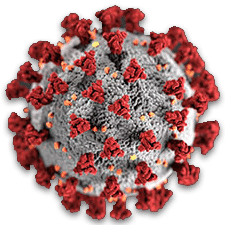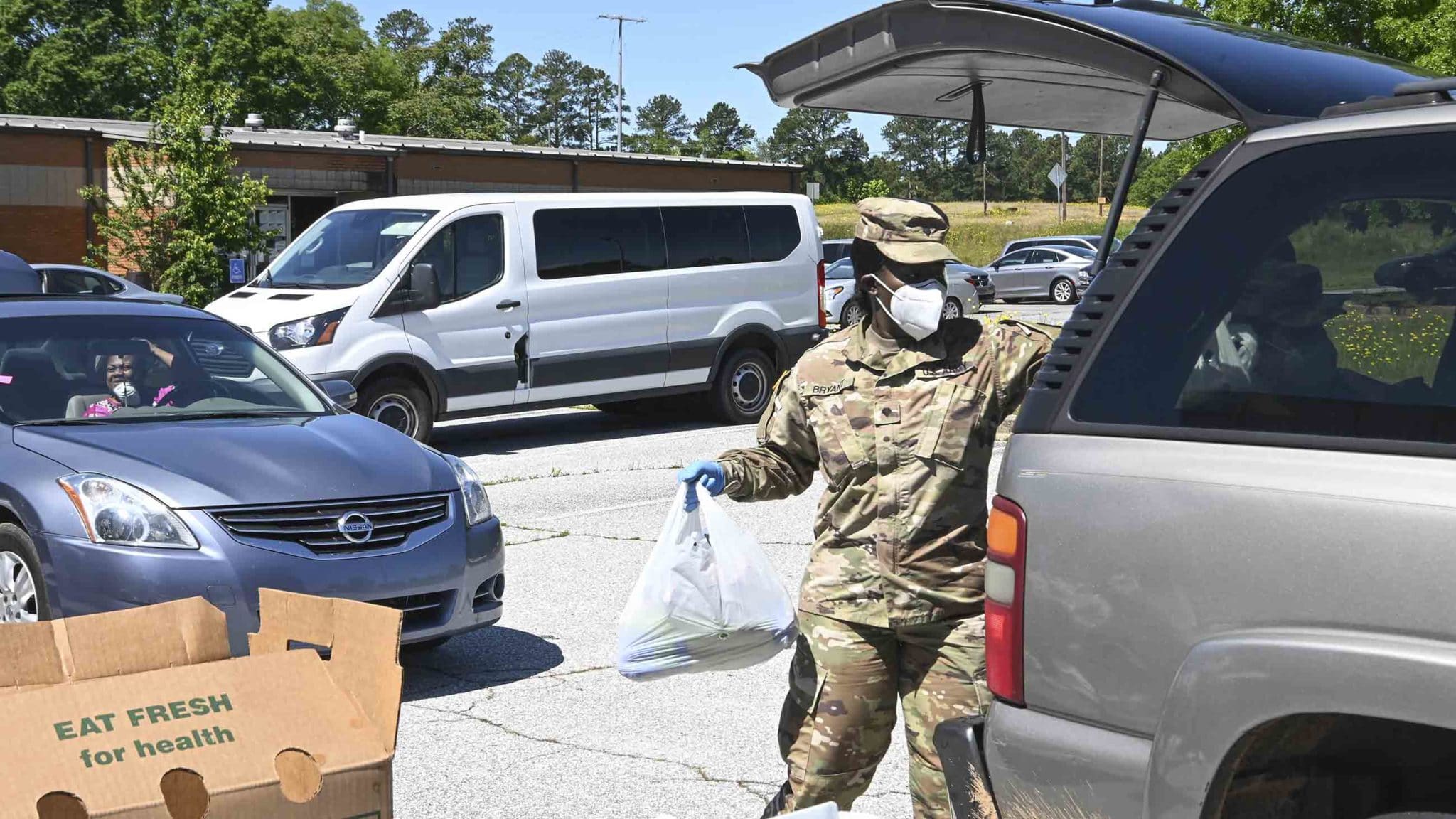As the Covid-19 death toll topped 75,000 in the United States this week, and the number of active unemployment claims rose to 33.5 million, a new report from the Brookings Institution found that two in five households with children under 12 are experiencing food insecurity.
“Rates of food insecurity observed in April 2020 are also meaningfully higher than at any point for which there is comparable data” the report notes — a period that stretches back to 2001. “Looking over time, particularly to the relatively small increase in child food insecurity during the Great Recession, it is clear that young children are experiencing food insecurity to an extent unprecedented in modern times.”
Other data presents a similar picture. A Marketplace-Edison Research Poll, released on Tuesday, suggested that 44 percent of American adults are “afraid they will be unable to afford food or groceries,” as many households face a sharp decline in income because of lost jobs or reduced hours. The pandemic continues to strain food banks, with rows of cars waiting to receive food stretching for nearly a mile in some places, and people standing in long lines. Feeding America, a national hunger relief organization, estimates that roughly 40 percent of people visiting food banks are seeking such assistance for the first time. Once they get there, food is not always available: For example, government documents obtained this week by The Guardian suggest that, at around 30 percent of recent food bank distributions in Texas, people have been turned away after supplies ran out.
These problems are not confined to the United States. Last month, the World Food Program estimated that, in the worst case scenario, famines could take hold in some three dozen countries in the next few months.
These grim statistics highlight the degree to which the Covid-19 pandemic is one of intersecting crises — the disease itself, but also the accompanying rises in hunger, domestic violence, and anxiety and depression. Managing those crises can, at times, seem like a cruel balancing act, with few good options: The very social distancing restrictions that ease the viral threat seem to prolong another danger; but easing distancing, experts fear, could lead to a spike in cases that will, in the long-run, further strain social life.
And not all these crises, of course, are exactly alike. The SARS-CoV-2 virus exists, and will for at least a while longer, regardless of any human effort. Food shortages in the U.S. may be a little less ironclad, at least in theory: The United States remains the wealthiest country in the world, and farmers keep farming. Indeed, just this week, after some delays, the U.S. Department of Agriculture announced plans to buy $470 million of surplus food — at least some of it earmarked for food banks.
The global food supply remains abundant, too, but Covid-19 lockdown measures have created barriers to distribution and hamstrung people’s ability to afford it.
In this week’s Abstracts, we deliver our weekly roundup of coronavirus stories that defined the week’s news, and that are likely to be relevant in the weeks ahead.
 |
Thoughts or questions on Covid-19? |
• Amid ongoing lockdowns, urban-dwellers around the world try to leave town.
Layoffs and fear of the coronavirus are causing many who live in crowded cities to seek respite in more spacious suburbs or to return to their hometowns. In the U.S., one recent poll found that nearly one-third of Americans are currently thinking about moving to less populated areas. Many people have already fled — if only temporarily — to second homes or to live with family across the country, raising concerns about the virus’s continued spread. New data suggests that travel from New York City before restrictions were imposed led to outbreaks in other states. Those leaving have faced criticism both at home and in their new destinations. Elsewhere, in India, hundreds of thousands of workers have been traveling on foot to return to more rural areas. And in Peru, nearly 170,000 people — many of whom have lost their jobs — have requested assistance from their local governments in leaving cities to return home. “In Lima we were not going to be able to live if I continued without work,” one man told The New York Times. Where his parents live in northwest Peru, he added, “we can hang on.”
• A violent arrest in New York City raises fears that social distancing enforcement has become a vehicle for racial profiling.
In a reflection of long-standing social inequalities, black Americans are likelier than their white counterparts to die from Covid-19, occupy frontline jobs, and run the risk of profiling and arrest when they don mandated face coverings. Many people have also expressed concern that, as police enforce social distancing rules, law enforcement officers are disproportionately targeting minorities. Indeed, advocates and officials took to social media over the weekend to condemn the actions of a plainclothes New York City police officer who was captured on video violently arresting a black man for violating social distancing rules. Some people juxtaposed the incident with images of officers from the same police force handing out masks to groups of white sunbathers. In response to the outcry, New York City Mayor Bill de Blasio said Wednesday that he would release data from the police department on social distancing enforcement and acknowledged that the department needed to improve and clarify its protocols. The first of that data, released on Thursday evening by the Brooklyn district attorney’s office, recorded that of 40 people arrested in the borough for distancing violations, one was white, and 35 were black. Last month, Democratic lawmakers sent a letter to federal law enforcement agencies urging them to provide specialized anti-bias training and guidance to police officers in light of the pandemic.
• As Covid-19 deaths climb in Sweden, experts and policymakers debate the merits of the country’s hands-off approach.
As Covid-19 spread in Europe earlier this year, country after country shuttered businesses and imposed strict social distancing rules. The notable exception was Sweden, where the state epidemiologist, Anders Tegnell, dismissed such restrictions as ineffective and argued that trusting citizens to behave responsibly would do as much to control the virus. While officials banned gatherings of more than 50 and recommended social distancing, restaurants, hairdressers, yoga salons, coffeeshops, and other businesses have continued to operate mostly as normal. “Pedestrians wearing masks are generally stared at as if they have just landed from Mars,” The New York Times reported in late April, around the time that the country’s health officials were heralding a successful strategy. At a press conference on Wednesday, though, Tegnell admitted to a “horrifying death rate,” especially among the country’s elderly. To date, Sweden has reported more than 25,000 cases of Covid-19 and more than 3,100 deaths. The numbers are startlingly different than in neighboring countries with lockdowns: Norway, for example, stands at just over 8,000 cases and 217 deaths. In an interview with The Daily Show’s Trevor Noah early this week, Tegnell said parts of the strategy had been successful. But he described his country’s cascade of deaths as a surprise; he and other epidemiologists had expected mostly milder illness and a growing population of citizens with protective immunity. “We calculated on more people being sick,” he said. “But the death toll really came as a surprise to us.”
• The federal government moves to tighten regulations on antibody tests for Covid-19, as demand for the tests grows.
Amid complaints about testing inaccuracies and misleading marketing, the U.S. Food and Drug Administration announced on Monday that it will tighten restrictions on makers of commercial antibody tests for the novel coronavirus. A March ruling had allowed the tests — designed to tell whether a person has previously been exposed to the virus and may therefore have immunity — to bypass the usual FDA review and verification process. Companies subsequently flooded the market with more than 200 tests, some falsely advertised as FDA approved. As of Monday, only a dozen antibody tests had been reviewed and authorized by the FDA, and one study of 14 commercial tests found that only three consistently gave reliable results. Under the new policy, companies will be given specific performance targets and will have 10 business days to submit their validation data to the FDA. The change comes as many government officials are looking to ramp up antibody testing, with an eye toward lifting social distancing restrictions. But experts caution that it’s unclear whether Covid-19 antibodies confer immunity, and for how long. “There are a lot of unanswered questions,” said FDA Commissioner Stephen Hahn.
• India begins to reopen, loosening the world’s largest lockdown.
The world’s second-most populous country moved this week to loosen some of its lockdown. Since late March, the country’s 1.3 billion residents have been under orders to stay in their homes. The government has now lifted restrictions, such as allowing liquor stores — a source of critical tax revenue for the government — to reopen. In response to long lines and failures to continue social distancing, however, some states have reversed the decision to reopen the stores. Police have also attempted to break up large crowds, assailing groups with long sticks in an effort to disperse them, but it’s not clear how effective, or widespread, those efforts have been. “There’s no police around, nobody is enforcing the lockdown, people are out everywhere,” a Delhi shopkeeper told The New York Times. Rising summer temperatures may help drive people out into the streets. Indeed, earlier this week, New Delhi reached a high of 104 degrees, and experts have predicted that India’s summer will soon get much hotter.
There’s plenty of excellent reporting and analysis available.
Below is a list of some of the journalists, experts, and publications that Undark is following.
- Helen Branswell (@HelenBranswell), senior writer, infectious diseases, STAT
- Peter Sandman and Jody Lanard, risk communication experts
- Kai Kupferschmidt (@kakape), molecular biologist and science journalist, Science Magazine
- Trevor Bedford (@trvrb), computational biologist, Fred Hutchinson Cancer Research Center, Seattle
- Lawrence Gostin (@lawrencegostin), professor of global health law, Georgetown University
- Muge Cevik (@mugecevik), infectious disease researcher, University of St. Andrews
- A. Marm Kilpatrick (@DiseaseEcology), infectious disease ecologist, UC-Santa Cruz
- Julia Belluz (@juliaoftoronto), health correspondent, Vox
- Ed Yong (@edyong209), science writer, The Atlantic
- Kaiser Health News, full coronavirus coverage
- ProPublica, full coronavirus coverage
- U.S. Centers for Disease Control and Prevention, latest coronavirus news
- World Health Organization, rolling coronavirus updates
- Global Covid-19 Case Tracker, Johns Hopkins Center for Systems Science and Engineering
- Brief19, a review of Covid-19 research and policy
- The Covid-19 Tracking Project
- The Syllabus, Coronavirus Reading Lists
- Virus Academics Twitter list
Undark will continue to provide weekly roundups of Covid-19 news each Friday for as long as the pandemic continues. You can find our own Covid-19 coverage here.
Deborah Blum, Lucas Haugen, Jane Roberts, Francesca Schembri, and Ashley Smart contributed to this roundup.











Comments are automatically closed one year after article publication. Archived comments are below.
What is food?